Exploring Living Furniture Trends in Dubai
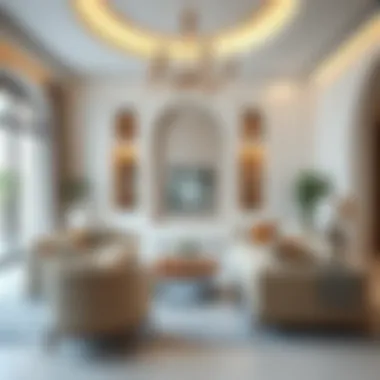
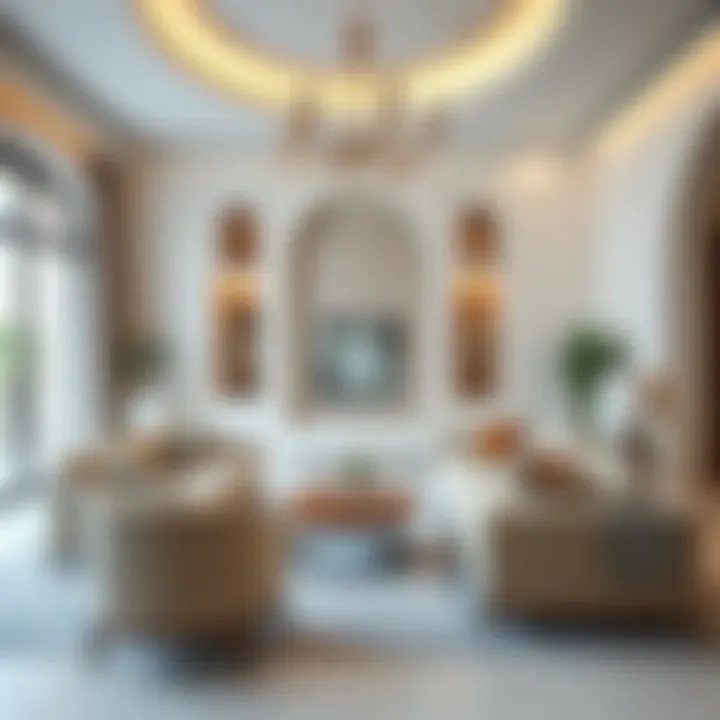
Intro
Dubai, a city renowned for its blend of tradition and modernity, presents a fascinating arena for the exploration of living furniture. The local market is not just a reflection of evolving tastes but also a canvas showcasing the unique cultural tapestry of the region. As one walks through the bustling streets and upscale showrooms, it becomes evident that living furniture is more than merely functional; it embodies lifestyle choices, social aspirations, and a quest for aesthetic harmony.
The interaction between design and utility plays a pivotal role in shaping how residents and investors select their furniture. This journey into Dubai's living furniture scene aims to illuminate the trends, key players, and cultural nuances that inform consumer preferences in this vibrant marketplace.
By focusing on the key elements that define living furniture in Dubai, we aim to provide valuable insights for homebuyers, renters, property managers, and investors. Whether you’re contemplating an investment in property or looking to decorate your new home, understanding the intricacies of living furniture in this city is paramount.
Intro to the Concept of Living Furniture
In today's fast-paced world, the art of living furniture takes on a unique significance, especially in a vibrant city like Dubai. This concept transcends the mere act of furnishing a home; it embodies a lifestyle choice that speaks to both comfort and style. Living furniture is not just about aesthetics—it's a means of cultivating a space that enhances daily activities while reflecting personal taste. As urban living becomes more prevalent, the demand for furniture that serves practical purposes alongside visual appeal has surged, making this a central theme of contemporary interior design.
Understanding living furniture involves recognizing its role in creating atmosphere and functionality. The relevance of this topic lies in its ability to influence how individuals experience their homes. For instance, modular sofas allow homeowners to rearrange their living spaces to suit gatherings, movie nights, or quiet evenings, indicating a shift towards adaptability in furniture design.
The Benefits of Living Furniture
Living furniture offers several advantages:
- Versatility: Many pieces can serve multiple functions. A coffee table might transform into a dining table, or a bench can double as a storage unit.
- Comfort: The focus is on creating inviting spaces for relaxation and socializing, essential in a city known for its vibrant social life and hospitality.
- Personal Expression: Homeowners can showcase their style by selecting pieces that reflect their personality, making the living space uniquely theirs.
Important Considerations
When discussing living furniture, it's crucial to consider factors such as:
- Space Constraints: In urban environments like Dubai, living spaces can be compact. Choosing furniture that maximizes utility without overcrowding is vital.
- Cultural Influences: The multicultural essence of Dubai necessitates an understanding of how various styles can coexist and harmonize.
- Sustainability: As awareness grows regarding environmental impacts, many seek furniture crafted from sustainable materials, blending style with a sense of responsibility.
In summary, the introduction to living furniture highlights a trend that is central to modern living in Dubai. This concept is more than just decor; it is a statement of lifestyle and values, intertwining functionality with elegance. By curating living spaces that cater to personal tastes and daily needs, residents not only enhance their homes but also enrich their overall quality of life.
Cultural Influences on Furniture Design in Dubai
In Dubai, furniture design is not just about aesthetics; it's a spectacular blend of cultural influences that reflect the life and history of its residents. The cultural tapestry of the emirate, rich with Arab traditions, international styles, and modern innovations, has formed a unique landscape for living furniture. Understanding this interplay helps uncover the values, nuances, and preferences that govern not only design choices but also consumer behavior within the local market.
Historical Context
The history of furniture design in Dubai can be traced back to its roots in Bedouin culture, where practicality ruled the day. Early inhabitants crafted functional pieces from available materials, prioritizing utility over flourish. For instance, traditional wooden chests served as storage and seating alike. These handcrafted items were often adorned with intricate carvings and patterns reflecting local artistry.
As Dubai evolved into a trading hub, influences from various cultures began to seep into its design ethos. From the opulent styles of Persian carpets to the minimalist lines of Scandinavian design, every influence has played a part in shaping modern living spaces. To highlight some of these influences:
- Bedouin Craftsmanship: Strong reliance on local materials, creating pieces that are functional yet beautiful.
- Persian Influence: Rich textures and intricate patterns became part of furniture characteristics, imbuing a sense of luxury.
- Global Styles: As Dubai's status as a multicultural metropolis grew, the influx of international designers brought with it a diverse range of styles, from sleek modernism to rustic chic.
This historical journey is reflected in the contemporary trends seen today, where a dialogue between traditional craftsmanship and modern design creates furniture pieces that tell a story.
Modern Adaptations
In contemporary Dubai, the marriage of the old and new manifests in bold ways. Designers are increasingly embracing a philosophy where tradition meets innovation. The result? Furniture that is not just designed to fit into a home but also to resonate with its inhabitants' identity.
- Fusion of Styles: Many local brands now create pieces that blend traditional craftsmanship with modern designs, as seen in the intricate details of contemporary tables that may echo Bedouin patterns while using minimalist structures.
- Sustainability Focus: Modern adaptations also include a growing awareness of environmental issues. Designers are opting for eco-friendly materials that uphold the fine art of craftsmanship while respecting the earth.
- Smart Furniture: The incorporation of technology into furniture design has taken off. Pieces that integrate charging stations or adjustable features can be found in homes catering to a tech-savvy clientele.
The adaptability of furniture in Dubai showcases a willingness to embrace change while honoring the past. With trends evolving at a rapid pace, designers continuously search for that sweet spot between heritage and modernity, thereby crafting living spaces that are as functional as they are aesthetically pleasing.
"The furniture in Dubai embodies a rich narrative that encapsulates both the whispers of history and the roars of modernity."
Ultimately, the cultural influences on furniture design in Dubai are deeply woven into the very fabric of its society. Understanding these influences not only provides insight into the local market but also paves the way for future innovations that continue to shape the art of living furniture.
Material Choices: A Focus on Quality
In the realm of living furniture, the quality and type of materials drastically influence both the aesthetics and functionality of the products. When it comes to Dubai's unique furniture market, discerning buyers often prioritize not just appearance but the longevity and ecological footprint of their selections. This section delves into the pivotal role that material choices play, highlighting sustainable options alongside luxurious finishes that cater to the sophisticated taste of the region's populace.
Sustainable Materials
The trend towards sustainability has become a cornerstone in the furniture industry, particularly in a rapidly evolving market like Dubai. Here, buyers are increasingly conscious of how their choices impact the environment. Furniture crafted from eco-friendly materials such as reclaimed wood, bamboo, and recycled metal demonstrate a commitment to sustainability without sacrificing style.
- Reclaimed Wood: This material brings history and character to a space. Each piece carries its own story, contributing to a unique ambiance. Typically, reclaimed wood adds a rustic charm while promoting responsible sourcing and conservation efforts.
- Bamboo: Not only is bamboo a renewable resource, but it’s also remarkably strong and lightweight, making it an excellent choice for furniture that is movable and versatile.
- Recycled Metals: Using recycled materials minimizes waste and reduces the need for new mining, which can be highly destructive to the environment. Designers are creatively using these materials to craft modern, sleek designs that captivate.
Choosing sustainable options can also appeal to a market that's becoming increasingly aware of its carbon footprint. Not to mention, these materials often lend themselves to creative designs that reflect an individual’s style yet remain rooted in ecological responsibility.
Luxury Finishes
While sustainability is increasingly important, the quest for luxury remains a significant player in the Dubai furniture scene. Buyers are drawn to finishes that evoke a sense of opulence and sophistication. This pursuit for high-end design is not just superficial—luxurious finishes often enhance durability and overall value of the furniture.
- Natural Woods: Richly grained hardwoods like walnut, teak, and mahogany are sought after for their durability and timeless appeal. These woods can be polished to a high sheen or finished mat, catering to different stylistic preferences.
- Metal Accents: Incorporating metals like brass and brushed nickel can elevate furniture aesthetics. These choices offer a contemporary feel and can link to a variety of design themes, reflecting both luxury and modernity.
- Upholstery: Luxurious fabrics such as silk, velvet, or high-grade leather are often preferred for upholstered pieces. They not only enhance comfort but also contribute to visual statements that invite opulence into a room.
Luxury finishes do not simply elevate the look of furniture but also serve a practical purpose. They can enhance resistance to stains, scratches, and wear, ensuring that the furniture remains beautiful and functional for years.
In summary, attentive material choices are foundational to living furniture in Dubai, where quality is intertwined with cultural aesthetics and sustainability. As buyers navigate the diverse offerings, understanding these elements equips them to make informed decisions that resonate with their values and lifestyle.
Key Trends in Living Furniture Design
Living furniture design in Dubai has evolved tremendously, mirroring the city’s rapid growth and its eclectic mix of cultures. In this context, understanding the key trends not only informs design choices but also impacts lifestyle, functionality, and even market value. Trends in living furniture often reflect broader shifts in society, such as changes in consumer preferences and technological advancements, making it a pertinent topic for buyers, renters, and real estate investors alike.
Minimalism and Functionality
Minimalism has made its mark on the living spaces of Dubai, serving as a refreshing antidote to the sometimes overwhelming opulence that characterizes the architecture and public spaces in the city. This trend emphasizes clean lines, simple forms, and a clutter-free aesthetic, which resonates well with the fast-paced lifestyle of its residents. The minimalist approach is not just about aesthetics; it promotes functionality. For instance, furniture pieces are often multi-purpose. A sleek coffee table might also serve as a storage unit, and a sofa can convert into a bed with a simple mechanism. This versatility appeals to homeowners who want to optimize their living space without sacrificing style.
Moreover, minimalism encourages homeowners to invest in fewer, high-quality pieces rather than filling a room with numerous lesser-quality items. By doing this, each piece can be cherished, reducing the distractions of over-decorated spaces. The results speak volumes — open, airy rooms that feel more inviting, and intimate, while also maintaining a sophisticated vibe. The emphasis on functionality means that designs are not just beautiful; they also play an active role in enhancing daily living.
Eclectic Styles and Personalization
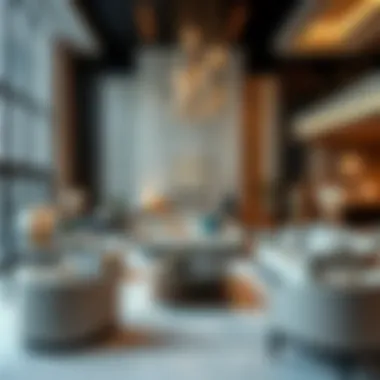
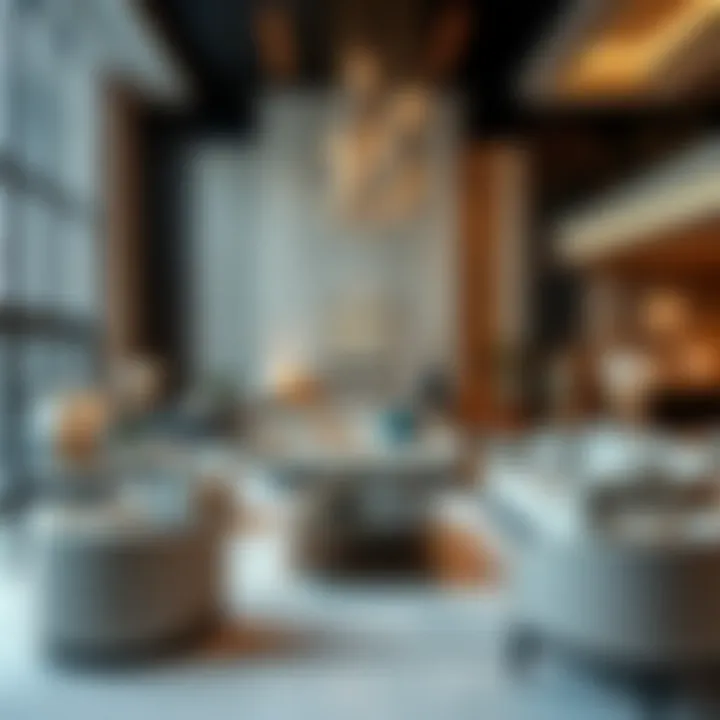
While minimalism takes center stage, the eclectic style is dancing just along the sidelines, offering a different palette of potential. This design approach embraces a mix-and-match philosophy, allowing homeowners to weave their personality into their spaces. In Dubai, where cultures converge, it’s not uncommon to see traditional Arabic elements melded with contemporary European influences or Asian design aesthetics.
Personalization is key here. Homeowners increasingly want their living spaces to be a reflection of who they are. This is achieved by incorporating items that tell their story—be it a vintage artifact picked up in a souk, a piece of contemporary art that sparks joy, or a custom-made sofa that fits their unique needs. The beauty of eclectic design lies in its flexibility; it invites creativity and experimentation, breaking the rigid rules of conventional design.
Popular Furniture Brands in Dubai
In the vibrant city of Dubai, where skyscrapers touch the clouds and luxury abounds, choosing the right furniture is paramount. The topic of popular furniture brands in Dubai isn’t just about name recognition. It's a reflection of the design ethic, quality standards, and cultural interplay that are key to this region’s lifestyle. A home in Dubai is more than merely a shelter; it’s a statement of identity and sophistication. Therefore, residents have gravitated towards brands that align both with aesthetic desires and functional demands.
Local Craftsmen and Artisans
When discussing local craftsmen and artisans, it’s crucial to recognize their pivotal role in the furniture scene. These businesses often blend traditional techniques with contemporary designs to create stunning pieces. Emirati artisans carry forward ancestral craftsmanship, infusing it with modern touches. For instance, intricate woodworking crafted into modern forms can be found at boutiques across the city. Local art and daily life merge here, as artisans prioritize their heritage while catering to the needs of an increasingly discerning clientele.
- Unique Offerings: Many artisans focus on custom pieces, making each item a reflection of the client's personality, not just an object. Whether it's a solid wood dining table built to last or handwoven textiles, each creation tells its own story.
- Sustainability Focus: A growing number of local artisans emphasize eco-friendly practices. This approach appeals to a conscious consumer base, ensuring that not only style but also sustainability is woven into the very fabric of furniture design.
Through their work, local craftsmen not only create functional pieces but also art that appreciates in value over time, resonating with both residents and visitors alike.
International Brands with Local Presence
The landscape of furniture in Dubai is also shaped by well-known international brands setting shop in this bustling city. These global enterprises bring a wealth of experience and a variety of styles that cater to diverse tastes. The influx of international brands offers homeowners a remarkable blend of styles from around the globe.
- Diverse Options: From Scandinavian minimalism to the elegance of Italian designs, brands such as IKEA, Baker Furniture, and Herman Miller provide everything from functional pieces to luxurious statement items. This variety allows individuals to design their spaces in a way that truly reflects their identity.
- Quality Assurance: International brands often uphold high-quality standards which can be essential for investors and homeowners. These brands usually provide warranties and quality guarantees that are reassuring in terms of investment.
- Access to Global Trends: With Dubai's strong ties to the international market, consumers benefit from trends and styles that are emerging around the world. For example, the rise in popularity of multi-functional furniture can be directly attributed to interactions with global markets, catering to the urban lifestyle.
In summary, both local artisans and international brands play essential roles in shaping the rich tapestry of the furniture market in Dubai. Together, they create an environment where style meets functionality, catering to a clientele that values both aesthetics and quality.
The Role of Showrooms in the Buying Process
In the realm of living furniture, showrooms play a pivotal role in helping consumers navigate the myriad of options available. They are not just places to browse; they are curated environments where potential buyers can engage with products before making a substantial investment.
Experiential Shopping
Experiential shopping is more than merely picking out a chair or a table; it involves immersing oneself in the setting and feeling the atmosphere that various pieces create. Showrooms in Dubai offer meticulously designed spaces where consumers can experience potential purchases in a realistic context. Imagine sauntering through a living set that mimics your ideal home—the soft glow of lighting casts shadows on elegant textiles, while the layout beckons for a gathering of friends. This kind of interaction is invaluable; it transforms shopping from a chore into a rich, sensory experience.
When homeowners step into a showroom, they aren’t just looking at isolated items but rather how these pieces would synergize in their living spaces. Customers often have the chance to touch materials, sit on sofas, and even envision how their lives would unfold in these curated environments. Such encounters reinforce decisions, steering buyers toward purchases that truly resonate with their lifestyle and aesthetic preferences.
Virtual Showroom Innovations
As technology weaves itself into various sectors, the furniture industry has not lagged behind, with virtual showroom innovations making waves, especially in Dubai's dynamic market. Consumers can now explore furniture collections from the comfort of their home. Although nothing can replace in-person experiences entirely, virtual showrooms offer a few unique advantages.
With 3D modeling and virtual reality technologies, potential buyers can navigate virtually designed spaces, giving them a mini-escape into a potential future where they can visualize furniture across various setups. This not only boosts confidence in purchasing but also caters perfectly to today’s fast-paced lifestyle where convenience reigns supreme.
Numerous local and international brands are investing in virtual platforms to enhance consumer engagement. For instance, a few clicks might lead you through a fully furnished apartment showcasing the latest in living furniture trends. Furthermore, these virtual experiences often provide tools for customization, allowing customers to adjust colors and fabrics, making it easier to envision personal preferences in real scenarios.
Virtual showrooms combine the tactile experience of physical stores with the convenience of online shopping, bridging the gap between the two worlds.
Finale
In sum, showrooms are an essential cornerstone in the buying process of living furniture in Dubai. They blend sensory experiences with various contemporary technologies, ensuring that consumers make informed decisions while also enjoying the journey of furnishing their spaces. Whether through engaging in experiential shopping or navigating innovative virtual showrooms, the process emphasizes the significance of understanding personal style and practical needs in creating an inviting home.
Purchasing Considerations for Homeowners
When delving into the world of living furniture in Dubai, it’s essential that homeowners consider several factors before making a purchase. Selecting the right furniture goes beyond mere aesthetics; it's about crafting a space that complements one’s lifestyle while ensuring long-lasting quality and satisfaction. This section will look at the key elements of budgeting for quality and how to select the style that resonates with the homeowner’s vision.
Budgeting for Quality
Setting a budget may seem straightforward, but in the realm of living furniture, it becomes a multifaceted task that requires careful thought and planning. It’s vital to understand that furniture is an investment. Choosing pieces that are not only beautiful but also durable will pay dividends over time.
- Quality vs. Price: It can be tempting to opt for the cheaper alternatives, but these may not withstand the wear and tear of daily life. Seek furniture that embodies both aesthetic appeal and robust materials. For example, investing in solid wood or high-density foam upholstery can offer greater longevity compared to cheaper options.
- Long-Term Investment: Think of furniture as an asset that appreciates in value when well-crafted. A handcrafted dining table might cost a chunk upfront, but over the years, its enduring charm and functionality make it worth every dirham.
- Lifecycle Costs: Also, consider the total cost of ownership, which includes maintenance, cleaning, and the need for potential replacements. For instance, a high-quality leather sofa may require periodic conditioning but will age gracefully, whereas a synthetic alternative might need replacing sooner due to wear.
Selecting the Right Style
Once the budget is set, the next step is to identify and select a style that truly reflects the homeowner's personality and preference. Furniture style can influence not just how a space looks, but also how it feels.
- Personal Taste: Styles vary widely, from minimalistic to maximalist, industrial to bohemian. Reflect on personal taste and consider how it aligns with the overall ambiance desired in the home. The elegance of a Scandinavian design offers simplicity, while a more eclectic approach infuses life and personal storytelling into the space.
- Cohesion: Ensure that the chosen style harmonizes with the existing decor of the home. A mismatch can easily disrupt the emotional comfort a space should provide. For instance, modern furniture with clean lines would clash with ornate traditional architecture, so ensure the design choices flow smoothly together.
- Functional Fit: While aesthetics are essential, never compromise on usability. Choose furniture that facilitates daily activities; for example, if you enjoy entertaining, opt for sociable seating arrangements. In a small apartment, multifunctional pieces like sofa beds or storage ottomans can maximize both style and space.
"In Dubai’s ever-evolving real estate market, making considered furniture purchases can significantly enhance property value and appeal."
In summary, homeowners embarking on their furniture purchasing journey must thoughtfully balance their budget with the quality and style that suits their unique living spaces. Taking the time to contemplate these elements can lead to a satisfying and enriching home environment.
Renting Furniture: A Growing Trend
The landscape of living furniture has seen a significant shift in Dubai, with renting furniture increasingly becoming a go-to option for many homeowners and renters alike. This change reflects not only economic considerations but also a lifestyle choice that emphasizes flexibility. In a city where the pace of life is fast and change is often the norm, the ability to furnish a home without the long-term commitment of purchasing is appealing. Renting furniture allows individuals to adapt spaces as their needs evolve, a critical benefit in a dynamic market like Dubai.
Short-term Solutions
Renting furniture serves as a practical solution for various situations. From expatriates who land in Dubai for job contracts to families who may be temporarily relocating, renting offers an effective way to create a comfortable living environment without incurring significant costs. This approach also benefits those who might not want to clutter their homes with permanent fixtures, especially in smaller living spaces.
Moreover, renting addresses unforeseen life shifts. Imagine someone who just moved to Al Quoz and intends to set up a living space that's as versatile as a Swiss Army knife. It's smart thinking; instead of investing heavily in furniture that may not fit their lifestyle in a year, they can opt for short-term rentals. This option can suite different needs like chic, minimalistic setups for a living area or even cozy arrangements for family gatherings.
Benefits of Rental Services
The benefits of rental services extend well beyond mere convenience.
- Cost-Effective: Renting furniture typically requires a fraction of the financial investment compared to buying. This allows tenants to allocate funds toward other necessities or luxuries such as fine dining or entertainment experiences in the city.
- Variety and Flexibility: One can easily switch styles and themes as trends change or personal preferences evolve, making it easier to refresh a space without the burden of permanent ownership.
- Ease of Setup: Many rental services include delivery, assembly, and even pickup when the lease is up, removing the hassle and physical strain of moving furniture.
"Renting isn't just about short-term savings; it's about seizing the flexibility that aligns with the lifestyle of modern urban dwellers."
- Sustainability: Choosing rental solutions can also reflect a more sustainable choice for eco-conscious individuals, as it promotes the circular economy of reusing furniture among multiple users.
- No Long-Term Commitment: The lack of a long-term commitment means that renters can feel free to experiment with their living situation without the fear of losing an investment in expensive furnishings.
In summary, as Dubai continues to evolve, so too does the lifestyle of its inhabitants. Renting furniture is more than just a trend; it's a strategic decision tailored for those who value mobility and the freedom to live life on their own terms.
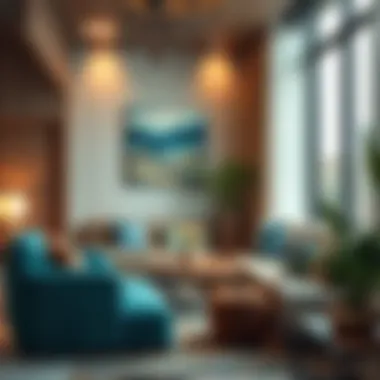

Furniture Maintenance Tips for Longevity
Taking care of living furniture goes beyond mere aesthetics; it's about preserving the essence of each piece. In a city like Dubai, where the interplay between heat and humidity can challenge the resilience of your furniture, understanding maintenance is crucial to ensure that your investments stand the test of time. Proper care not only prolongs the life of your furnishings but also upholds their value, an especially significant consideration for homeowners and investors alike.
Cleaning and Care Routines
Keeping furniture looking its best involves establishing and sticking to a cleaning routine. This doesn’t mean turning your living space into a showroom but rather incorporating a few practices into your regular chores:
- Dusting: Make it a habit to dust surfaces weekly. Fine particles can significantly scratch and damage your furniture if left alone. Use a soft cloth or a microfiber cloth to avoid harm.
- Vacuum Regularly: Upholstered furniture requires vacuuming to remove dirt and debris that can settle into the fabric. A handheld vacuum with an upholstery attachment works wonders.
- Spot Cleaning: Accidents happen. Whether it’s a spilled drink or food, attend to stains immediately. Use a mild soap solution and blot—don’t rub. For fabric, an upholstery cleaner is necessary, while a mix of vinegar and water can work for most wooden finishes.
- Conditioning Wooden Surfaces: Depending on the wood type, using a good quality wood conditioner can nourish and protect the material. This should be done every 6-12 months, depending on usage and exposure to sunlight.
"High-quality furnishings need attention as much as they need style. A few routine practices can change everything."
Preserving Value over Time
Maintaining the value of your furniture can be likened to maintaining a classic car; it takes time, patience, and a bit of effort. The return on this investment isn’t merely financial—there’s also the joy of enjoying beautiful surroundings:
- Use Coasters and Mats: The sun-drenched Dubai climate can wreak havoc on furniture surfaces. Always place coasters or mats under cups, vases, and decorative items to prevent scratches and heat burns.
- Rotate Furniture: It’s easy to forget that furniture, just like anything else, takes on wear patterns over time. Regularly changing the layout or simply rotating your couch can lessen stress on certain areas and keep it looking vibrant.
- Avoid Direct Sunlight: If you live in a lively area of the city where sunlight pours through the windows, consider using curtains or window films. Overexposure can lead to fading and drying out of materials, impacting the overall appearance and longevity of your furniture.
- Professional Refurbishment: Consider professional repair and recovery options when your furniture shows signs of serious wear. From reupholstering to refinishing, investing in expert services can be a game-changer in retaining or even enhancing value.
The Influence of Interior Designers on Trends
Interior designers wield significant influence over the furniture market and the broader aspect of home decor in Dubai. By marrying creativity with practicality, these professionals play a pivotal role in shaping trends that resonate with local culture and global aesthetics. Understanding this synergy is essential for anyone looking to invest in or design living spaces in this vibrant city.
The collaboration between interior designers and furniture brands has birthed a new era of design that favors customized solutions over mass-produced pieces. As designers delve into their clients' personal stories, they curate furniture choices that reflect individuality while adhering to functionality. This approach not only enhances the living space but also ensures that each piece serves a purpose, making it a valued element of the home.
Collaboration with Furniture Brands
A key component of successful interior design is the collaboration between designers and furniture brands. These partnerships can be seen in many contemporary projects across Dubai. Designers often engage with brands that prioritize local craftsmanship, promoting pieces that speak to the heritage and artistry of the region. A fine example can be observed in how local artisans, influenced by traditional Emirati culture, integrate modern styles into their work.
For instance, brands like Tashkeel and S concept store showcase various bespoke furniture that resonates with the tastes of diverse clients. Their collaboration with designers allows for a fusion of innovative ideas and cultural narratives, resulting in furniture that is not just functional but also an extension of the homeowner's identity.
Moreover, as global brands establish a presence in Dubai, they often adapt their offerings to cater to local sensibilities. This dialogue between international standards and local tastes leads to innovative designs where both aesthetics and cultural roots are celebrated.
Creating Unique Living Spaces
Creating unique living spaces goes beyond mere decoration; it reflects the personality and lifestyle of the inhabitants. A thoughtful approach to interior design involves understanding how spatial arrangement, color palettes, and furniture styles harmonize to create an inviting atmosphere.
In Dubai's cosmopolitan environment, interior designers play an essential role in tailoring spaces for a range of lifestyles. Whether it’s a lavish penthouse overlooking the skyline or a cozy family villa, each space tells a different story.
Key Factors in Crafting Unique Spaces:
- Personalization: Designers often incorporate personal items and heirlooms, ensuring that the furniture selection aligns with the homeowner's life experiences.
- Cultural Elements: Including local art or furniture that reflects Emirati traditions connects the space with its heritage, creating a sense of belonging.
- Functionality: Practical considerations, such as ease of movement and utility, are prioritized to ensure that the space remains user-friendly without compromising on style.
"Good design is about making spaces that are enjoyable to be in, where people can thrive and feel at home."
Ultimately, the convergence of interior design with furniture trends results in curated environments that meet both aesthetic desires and practical needs. As Dubai continues to evolve, the role of interior designers in shaping living furniture trends will remain crucial, influencing how residents interact with their spaces and enhancing their overall quality of life.
Regional Property Market Overview
The property market in Dubai stands as a focal point for both local and international real estate activities. Its vibrant landscape is continuously evolving, and understanding this aspect is crucial for anyone interested in the art of living furniture. The regional property market does more than merely house furniture; it shapes the very fabric of how living spaces are crafted, experienced, and valued.
Real estate trends directly influence the demand for various sorts of living furniture, which in turn reflects the preferences and lifestyles of homeowners. As areas within Dubai flourish, furniture design adapts to mirror the lifestyles emerging from those neighborhoods, breeding an intricate dance between aesthetics and function.
This overview not only serves to inform potential real estate investors but also provides insight for homeowners, renters, and property managers who want to curate an inviting and stylish atmosphere.
Emerging Neighborhoods
Dubai's urban sprawl offers a myriad of neighborhoods, each with its unique personality. From the bustling streets of Downtown Dubai to the serene vibes of Jumeirah, each area brings its own flavor to the living furniture market. Emerging neighborhoods, such as Dubai Marina and Dubai Hills, showcase a blend of modern design and traditional influences.
These neighborhoods often attract younger demographics or expatriates who desire a space that resonates with contemporary aesthetics while offering the comforts of home. Styled to meet the needs and wants of these diverse populations, furniture choices in these locales can reflect functionality and artistic expression.
- Dubai Marina: Known for its upscale living, the furniture here often emphasizes sleek designs with high-quality finishes. Residents typically lean towards minimalistic styles that echo the opulence of the skyline.
- Dubai Hills: This newly developed neighborhood blends nature with luxury. The furniture tends to harmonize with the beautiful outdoor landscape, incorporating natural materials and colors that reflect the nearby parks and greenery.
The vibrancy of these emerging areas highlights the importance of furniture choices, as homeowners seek to create environments that not only look appealing but also feel like an extension of their aspirations.
Investment Potential
Investing in Dubai's property market presents a wealth of opportunities, especially concerning living furniture. The integration of attractive, well-designed furniture into properties can significantly increase their market value. According to recent trends, well-furnished homes not only sell faster but often command higher sale prices. Thus, selecting quality living furniture becomes paramount.
Here's why savvy investors should take note:
- High Demand for Rentals: With many expatriates arriving in Dubai, the demand for rental properties remains high. Landlords who furnish their properties attract more tenants, making investment in living furniture a wise decision.
- Synergy with Emerging Trends: As sustainability and design trends shape consumer preferences, investors can benefit by incorporating eco-friendly furniture or unique designs that align with client expectations.
- Long-Term Value: High-quality, durable furniture enhances the overall aesthetic of a space. This leads to satisfied tenants and homeowners, ensuring that properties maintain their valuation over time.
In summary, the interconnectedness between the regional property market and living furniture in Dubai cannot be overstated. Investors, homeowners, and renters must recognize the strategic importance of selecting the right living furniture to not only reflect their personal style but also enhance the value and appeal of their spaces.
"Successful furniture choice can elevate a living space from just comfortable to truly captivating."
As Dubai continues to develop, the relationship between property, lifestyle, and furniture will only deepen, paving the way for an enriched living experience.
Technology Integration in Furniture Design
In the realm of living furniture in Dubai, the marriage between technology and design stands as a pivotal advancement. This integration not only enhances functionality but also elevates the overall user experience. Employing technology in furniture design is a thoughtful response to changing lifestyles and consumer expectations, merging clever engineering with aesthetic appeal.
Furniture pieces have evolved from mere physical objects to smart solutions engineered to enrich living spaces. For instance, imagine a coffee table that transforms into a workstation at the touch of a button or a sofa that adjusts itself to the optimal comfort level based on the time of the day or the user’s preferences. Such smart furniture solutions represent an essential shift in how space is utilized, making homes more versatile without compromising on style.
In the bustling markets of Dubai, where luxury is intertwined with innovation, the benefits of technology in furniture design are twofold. First, these advancements cater to the fast-paced lifestyle of the residents, allowing for multifunctional use of spaces that can adapt to various activities—be it work, leisure, or hosting. Second, it aligns with the growing demand for sustainability. Today's consumers increasingly seek products that not only function well but also minimize their environmental impact.
Moreover, technology provides homeowners with tools to optimize their living environments. For example, automated systems can help control lighting and temperature, enhancing comfort and efficiency. As urban living spaces become more compact, the role of technology in maximizing every square inch becomes ever more critical.
"Incorporating technology into furniture is not merely about keeping up with trends but creating a holistic living experience that resonates with modern day needs."
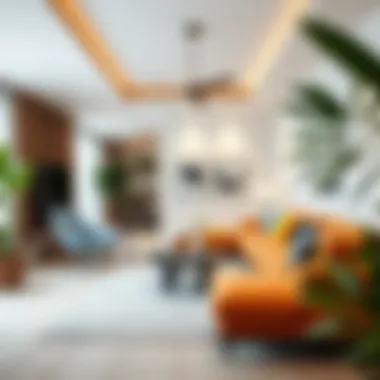
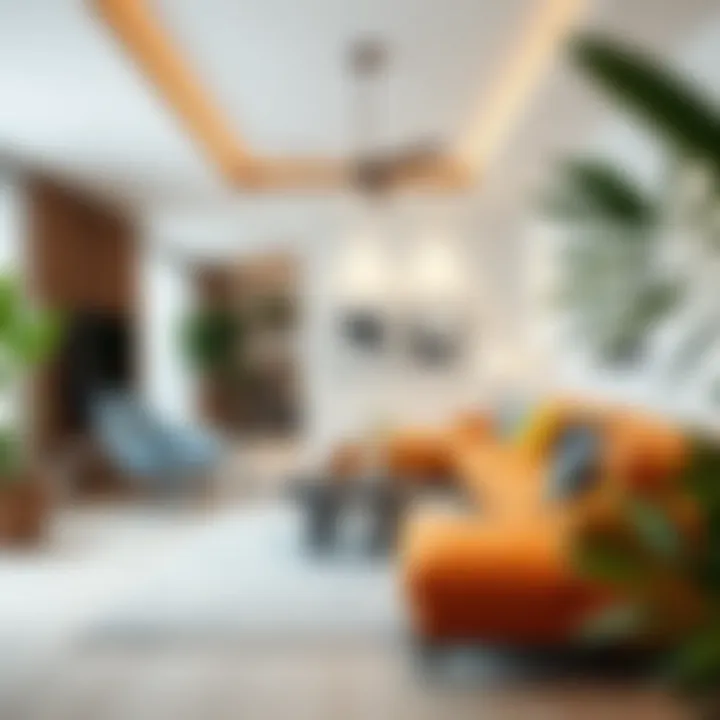
Smart Furniture Solutions
Smart furniture solutions have taken off in recent years, particularly in cities like Dubai where the eclectic mix of tradition and modernity flourishes. These innovations are designed with a keen focus on user-friendly experiences. They often incorporate features such as wireless charging stations embedded in desks or side tables, optimizing functionality without cluttering surfaces with cables.
Additionally, smart sofas equipped with integrated sensory technology can adjust their form based on the user’s posture. This is not just a luxury—it's a step towards promoting healthier living. Homeowners can also reap the benefits of app-controlled furniture, where living room layouts can be rearranged with a simple tap on a smartphone.
Not just limited to comfort and convenience, smart furniture is also about enhancing security. Some modern designs come with built-in security features, such as surveillance cameras hidden within artistic decor, ensuring safety while maintaining an aesthetic appeal. It's a clear demonstration of how technology blends seamlessly with everyday living.
Sustainable Innovations
The push for sustainability has become a driving force in furniture design, compelling brands in Dubai to rethink their production practices and material sourcing. Sustainable innovations focus on reducing waste, conserving resources, and utilizing recycled materials, aligning with global efforts towards environmental responsibility.
For instance, manufacturers are now creating furniture from sustainably harvested wood, biodegradable composites, and recycled metals. This shift not only reduces ecological impact but also resonates deeply with eco-conscious consumers who prioritize products that reflect their values. Furthermore, concise supply chains have been developed to minimize carbon footprints and enhance transparency in the sourcing of materials.
Integrating sustainability into furniture design doesn’t stop at materials. Many brands are adopting a circular economy approach, designing products that can be easily disassembled and recycled at the end of their lifespan. This innovative thinking encourages responsible consumption, a principle that is gaining traction in the luxury market.
The integration of technology and sustainability is poised to redefine the furniture landscape in Dubai. As residents aspire to design spaces that reflect their identities while caring for the planet, the continuing evolution of these innovations promises a richer, more thoughtful approach to living furniture.
Case Studies of Successful Living Spaces
In the realm of living furniture, case studies stand as compelling narratives that shape our understanding of design effectiveness and consumer preferences. These real-world examples cast a spotlight on successful interior spaces that harmonize aesthetics and functionality. They serve as a roadmap for homeowners, designers, and investors alike, revealing how thoughtful considerations can transform a mere house into a vibrant living space. Ultimately, these stories provide insights on practical solutions, marrying the creativity found in furniture design with the realities of modern living.
Residential Projects
Residential projects often embody the essence of personal style and everyday functionality. Take, for instance, a contemporary villa in Dubai’s upscale Jumeirah neighborhood. Here, the use of high ceilings creates a sense of openness. This spaciousness is complemented by custom-made furniture that serves not only as seating but also as art pieces. Consider a large, geometric coffee table crafted from reclaimed wood, enhancing both sustainability and design appeal. Small details, such as cushions sewn from local textiles, connect the home to its cultural roots, making the space intimately personal.
Spaces like these demonstrate how choices in living furniture can influence everyday life. Smart storage solutions provide homeowners ease and organization, while ergonomically designed pieces ensure comfort throughout the day. Visual elements like contrasting colors or unexpected textures amplify charm and warmth, creating a cozy ambiance.
Commercial Spaces
When it comes to commercial spaces, the needs shift slightly but remain equally crucial. A prime example is a trendy cafe in Dubai Marina, where the furniture reflects the brand's identity while catering to guests. Here, durable yet stylish chairs allow for long stays without compromising comfort. Open-topped tables with rich woods invite people to come together, fostering community interaction. The design stresses both utility for the business and experience for the customer, a balance vital to any successful commercial undertaking.
In commercial spaces, case studies highlight not just aesthetic appeal but also strategic planning. Designers often have to consider how furniture arrangements affect foot traffic or conversation flow, ensuring that every piece serves a purpose. This level of planning underlines the important collaborative dynamic between space, design, and function.
"Good design brings continuity and equity to spaces, creating links that make each visit a familiar journey."
This statement encapsulates the heart of successful living spaces. They are narrations that help blend beauty with purpose, providing vibrant atmospheres whether in homes or businesses. By analyzing both residential and commercial projects, we gather invaluable insights into maximizing space, enhancing livability, and developing furniture solutions tailored to diverse needs.
The Future of Living Furniture in Dubai
The evolution of living furniture in Dubai is a fascinating tapestry, intricately woven with the threads of tradition, technology, and modern design. As the city continues to urbanize and develop, the future holds several pivotal shifts that will profoundly affect how residents interact with their living spaces. This section delves into emerging trends and the anticipated shifts in consumer preferences that are set to shape the year's ahead.
Predicted Trends
Dubai's living furniture landscape is on the cusp of notable transformations as both residents and designers navigate a new wave of ideas. Firstly, sustainability has become the buzzword among consumers and brands alike. An increasing number of buyers are seeking eco-friendly options, which are not just good for the environment but also exude a sense of responsibility. This trend stretches from furniture pieces made from reclaimed wood to fabrics sourced from sustainable materials.
Alongside sustainability, smart technology integration is revolutionizing the way furniture is perceived and utilized. Imagine couches that adjust their firmness based on the user’s preferences or tables that can recharge your devices wirelessly. Such advancements are becoming ever more popular, providing an experience beyond plain aesthetics and comfort.
Moreover, there is a noticeable swing toward biophilic design, where elements of nature are integrated into living spaces. This can manifest in furniture pieces that incorporate natural shapes, textures, and even greenery, enhancing not just the look of a space, but also the mental well-being of its inhabitants.
"As the world turns more towards urban living, the demand for furniture that combines aesthetic appeal with functional versatility is skyrocketing."
Lastly, customization is gaining traction. Consumers are less inclined to settle for one-size-fits-all. A hodgepodge of styles based on individual taste can often be seen, leading to eclectic pieces that tell unique stories.
Consumer Preferences Shifts
As the cultural fabric of Dubai continues to evolve, so do the preferences of its residents. Younger generations, particularly millennials and Gen Z, tend to favor functionality combined with a sense of style. They're keen on investing in pieces that not only serve a purpose but also make a statement about their identity and lifestyle. For them, furniture is no longer just about looks; it’s also about experiences conveyed through design.
Furthermore, the rise of remote work has reshaped the demand for home office furniture. People are looking for multifunctional items that can effortlessly shift between workspace and leisure space, which paints a vivid picture of versatility in modern living.
In addition, consumer attitudes are trending towards minimalism. It's a stark contrast to the once opulent tastes of the past, emphasizing clean lines and a clutter-free environment. This shift is not merely aesthetic but also reflects a desire for mental clarity and simplicity in an increasingly fast-paced world.
With such transformations in mind, both industry players and homeowners need to stay attuned to these evolving preferences, ensuring that investments made in furniture align closely with the broader shifts in lifestyle and values. The future of living furniture in Dubai is not just about what is trendy but how these designs resonate deeply with the lives they serve.
Conclusively Balancing Aesthetics and Utility
In the realm of living furniture in Dubai, a critical conversation revolves around the delicate interplay between aesthetics and utility. This topic is not merely a design consideration; it is paramount for creating spaces that resonate with both beauty and practicality. As many homeowners and renters in Dubai navigate their decor choices, understanding how to strike this balance becomes essential to crafting a welcoming environment that works for them.
The Significance of Aesthetic Appeal
Aesthetic appeal often grabs immediate attention. In a city known for its opulence and architectural marvels, the furniture chosen plays a central role in reflecting personal style, culture, and even status. Furniture pieces can be seen as extensions of the homeowner's identity, thus should evoke a poignant emotional response. Beautifully crafted items, showcasing intricate designs or distinct colors, enhance the overall ambiance of the interior.
Moreover, the landscape of Dubai showcases a rich tapestry of cultures, and this diversity is reflected in the furniture choices. From sleek modern lines to ornate traditional motifs, the aesthetic spectrum is vast, allowing individuals to express unique narratives through their living spaces.
The Importance of Functionality
While pleasing to the eye, furniture must also deliver on functional promises. The fast-paced lifestyle of Dubai demands that living spaces adapt to various needs—from cozy family gatherings to impromptu meetings. High-quality living furniture must be durable, easily movable, and versatile to cater to these dynamic circumstances.
For instance, modular couches or expandable dining tables address practical needs without compromising on style. Such adaptability is particularly advantageous in urban settings, where space is often at a premium. The integration of utility ensures that the living environment meets the ongoing lifestyle requirements of its occupants.
Bridging the Gap
The challenge arises in finding furniture that masterfully combines both aesthetics and utility, and successful brands are rising to meet this demand. Many local and international designers understand that modern consumers are savvy; they seek products that are not only visually stunning but also serve multiple functions. Such considerations include:
- Versatile Designs: Furniture that offers multi-functional benefits, like a bed that doubles as a sofa.
- Quality Craftsmanship: Ensuring durability while maintaining a chic appearance, allowing for longevity in both design and function.
- Space Efficiency: Smart designs allow for compact living without sacrificing style, a crucial factor in the city’s urban landscape.
"In Dubai, living furniture must be more than just beautiful; it should reflect a lifestyle that embraces both functionality and elegance."
Consumer Insights and Trends
As market research indicates, buyers are leaning toward options that seamlessly marry aesthetic elegance with practical function. Homeowners are no longer choosing between beauty and utility; they expect both. This shift impacts purchasing decisions, driving brands to innovate and adapt to consumer preferences.
The End
Conclusively, balancing aesthetics and utility is an art form in itself, essential for the modern living experience in Dubai. As taste evolves, so too must the furniture that fills our homes—each piece serving not only as a visual delight but as a contributing factor to the day-to-day functioning of life. Investors, homebuyers, and property managers should keep this balance in mind when navigating the local furniture market, as it is a pivotal aspect of creating truly livable spaces that resonate with its inhabitants.







